|
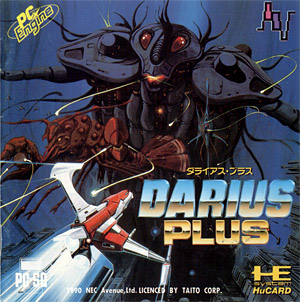
|

|
|
ダライアス プラス
1990 NEC avenue,Ltd.
Licensed by Taito Corp.
Release : 1990-09-21 (¥9800)
HuCard (6 Mbits) NAPH-1009
Shooter / Horizontal
|
Darius Plus is a horizontal shooter and is the conversion of the arcade game
Darius originally released by Taito in 1986. Massive and aquatic looking
mechanical entities are heading towards planet Darius, and they are clear warning
signs of an imminent attack. A courageous pilot, Proco Jr., on-board his
Silver Hawk space fighter, is given the perilous mission of stopping the upcoming war.
The ship is equipped with two attack weapons - a forward facing laser and ground bombs. A
third feature is a powerful force field shield that the player can activate to protect a
small perimeter around the ship. As aforementioned, although the game only features two
weapons and one shield option, they can be incrementally upgraded by collecting orbs left
behind by colored enemy ships - Red orbs upgrade the main weapon (from Missiles
to Lasers and Waves), Green orbs upgrade the bombs (from Simple
to Twin and Multi) and Blue Orbs upgrade the shield (Arm, Super
and Hyper). Additionally, other orbs are available for the picking - some destroy all enemies
on screen whereas others award the player with Extra Lives or Points. But the upgrade
system in Darius is unlike any others - although each collected orb gradually enhances a
weapon, a total of eight much be stored to finally upgrade it to the next level (and losing a life
takes the ship back to the lowest level). Finally, Darius features an unique
branching level progression in which the player can choose an alternate path to take at the
end of each stage. Although only seven levels can be accessed in one single play, the whole game boasts a total
of twenty six different stages. Unlike the original arcade game, Darius Plus is single player only.
|
 The original Darius arcade game was released by Taito in 1986,
and used an impressive large display made out of three color monitors aligned left
to right, giving the player an unique and incredible panoramic view of the action
(as pictured). No need to say that this unforgettable feature, as well as its magnificent
bosses cleverly inspired by submarine aquatic life, made Darius stand out in the
very crowded field of arcade shooters in the 1980s. Darius was ported to the
Commodore Amiga and Atari ST in 1989, and renamed Darius Plus for the occasion
(these ports were developed by The Edge and are a complete disgrace to the series
The original Darius arcade game was released by Taito in 1986,
and used an impressive large display made out of three color monitors aligned left
to right, giving the player an unique and incredible panoramic view of the action
(as pictured). No need to say that this unforgettable feature, as well as its magnificent
bosses cleverly inspired by submarine aquatic life, made Darius stand out in the
very crowded field of arcade shooters in the 1980s. Darius was ported to the
Commodore Amiga and Atari ST in 1989, and renamed Darius Plus for the occasion
(these ports were developed by The Edge and are a complete disgrace to the series
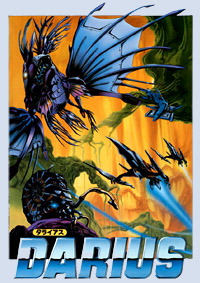 though). It was also ported to the PC Engine in 1990 - however, two versions were
available; a CDRom version called Super Darius and a Hucard version
called Darius Plus (see the section bellow for more information). As a side note,
another conversion was made available for the Game Boy Advance in 2001 - Darius R,
despite featuring a remixed soundtrack and 'enhanced' graphics, doesn't really add anything of
value to the original game... A sequel to the first arcade game was released in 1989 - Darius II
used an identical wide display and a similar gameplay. As for home conversions, things got a bit complicated...
For some strange reasons, the game is also known as Sagaia, especially in the west. Darius 2
was ported to the Sega Megadrive (1990) and renamed Sagaia in the US. Beside, a
Master System port also called Sagaia was exclusively released in Europe in 1991. Finally,
a Game Boy version was exclusively released in Japan in 1991 and was also called Sagaia!
However, strictly speaking, the game is not a direct conversion but a sort of remixed version of the
first two games. Then, in 1993, an enhanced port called Super Darius 2 was released for the
PC Engine Super CD system. Finally, an arcade perfect conversion was released for the
Sega Saturn in 1996, and this exclusively in Japan and Europe. Then, surprisingly,
though). It was also ported to the PC Engine in 1990 - however, two versions were
available; a CDRom version called Super Darius and a Hucard version
called Darius Plus (see the section bellow for more information). As a side note,
another conversion was made available for the Game Boy Advance in 2001 - Darius R,
despite featuring a remixed soundtrack and 'enhanced' graphics, doesn't really add anything of
value to the original game... A sequel to the first arcade game was released in 1989 - Darius II
used an identical wide display and a similar gameplay. As for home conversions, things got a bit complicated...
For some strange reasons, the game is also known as Sagaia, especially in the west. Darius 2
was ported to the Sega Megadrive (1990) and renamed Sagaia in the US. Beside, a
Master System port also called Sagaia was exclusively released in Europe in 1991. Finally,
a Game Boy version was exclusively released in Japan in 1991 and was also called Sagaia!
However, strictly speaking, the game is not a direct conversion but a sort of remixed version of the
first two games. Then, in 1993, an enhanced port called Super Darius 2 was released for the
PC Engine Super CD system. Finally, an arcade perfect conversion was released for the
Sega Saturn in 1996, and this exclusively in Japan and Europe. Then, surprisingly,
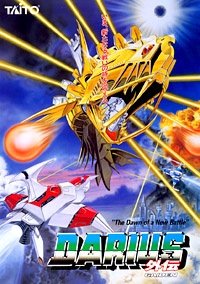 Taito shied away from the arcade market for a few years and released two additional Darius
games for the Super Famicom - Darius Twin in 1991
and Darius Force
(aka Super Nova) in 1993. Then the true arcade sequel to Darius followed in 1994 - the game,
called Darius Gaiden (picture on the right), dropped the wide display characteristic of the first two games and used a
more traditional single screen. It was ported to the Saturn (1995), Playstation (1996)
and for PC Windows (1998). The game was also included in Taito Memories Jōkan released
for the Playstation 2 in 2005, and in Taito Legends 2 released in 2006 for the
Playstation 2, XBox and PC. Then G Darius, the first polygonal 3D
opus in the series, hit the arcades in 1997. It is considered the epitome of the series (and
for substantive reasons), and was ported to the Playstation (1998) and included in
Taito Memories Jōkan released for the Playstation 2, and in Taito Legends 2
released in 2006 for the Playstation 2. Darius Burst was then released for the
Playstation Portable in 2009 and followed the formula established by the previous games.
However, Taito decided to go all out and to release the incredible arcade game
Darius Burst Another Chronicle in 2010. The game holds true to the Darius series and
features an extra wide screen display made out of two 32-inch LCD monitors as well as 4 different
ships (and therefore a 4-player coop option !).
Taito shied away from the arcade market for a few years and released two additional Darius
games for the Super Famicom - Darius Twin in 1991
and Darius Force
(aka Super Nova) in 1993. Then the true arcade sequel to Darius followed in 1994 - the game,
called Darius Gaiden (picture on the right), dropped the wide display characteristic of the first two games and used a
more traditional single screen. It was ported to the Saturn (1995), Playstation (1996)
and for PC Windows (1998). The game was also included in Taito Memories Jōkan released
for the Playstation 2 in 2005, and in Taito Legends 2 released in 2006 for the
Playstation 2, XBox and PC. Then G Darius, the first polygonal 3D
opus in the series, hit the arcades in 1997. It is considered the epitome of the series (and
for substantive reasons), and was ported to the Playstation (1998) and included in
Taito Memories Jōkan released for the Playstation 2, and in Taito Legends 2
released in 2006 for the Playstation 2. Darius Burst was then released for the
Playstation Portable in 2009 and followed the formula established by the previous games.
However, Taito decided to go all out and to release the incredible arcade game
Darius Burst Another Chronicle in 2010. The game holds true to the Darius series and
features an extra wide screen display made out of two 32-inch LCD monitors as well as 4 different
ships (and therefore a 4-player coop option !).
|
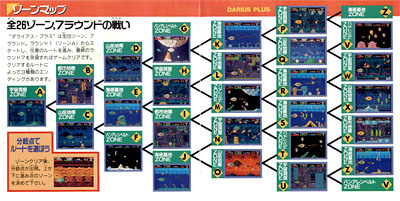 This PC Engine Hucard version has a couple of interesting differences with
the original arcade game. Obviously, the screen is not as wide as the original display
(the PC Engine could only run on a 4:3 standard-definition TV screen after all), so
developers had to crop the image and compress the action into a much smaller space - but it
actually works pretty well. Additionally, the conversion has lost the two-player option and
is single-player only. However, Darius Plus is somehow easier and it resurrects the player
on the spot rather than taking him back to the beginning of the stage (unlike the original arcade
game). But the game is called 'Darius Plus', and the reason behind this suffix is that it
features more bosses than the original arcade game. Darius had a total of eleven different
bosses whereas Darius Plus featured sixteen (see the Omake section). Additionally, four bosses from Darius
were cut from Darius Plus (Fatty Glutton, Iron Hammer, Strong Shell
and Great Thing), so the game in
reality features nine new bosses - all borrowed from the arcade game Darius II released in 1989 -
Big Rajarnn (Zone D), Little Stripes (Zone E),
Guard Savage (Zone G & I), Red Crab (Zone H & J), Hard Mollusk (Zone K & N),
Tough Spring (Zones L & O), My Home Daddy (Zones P & T), Mystic Power
(Zones Q & S) and Fire Star (Zones R & U).
This PC Engine Hucard version has a couple of interesting differences with
the original arcade game. Obviously, the screen is not as wide as the original display
(the PC Engine could only run on a 4:3 standard-definition TV screen after all), so
developers had to crop the image and compress the action into a much smaller space - but it
actually works pretty well. Additionally, the conversion has lost the two-player option and
is single-player only. However, Darius Plus is somehow easier and it resurrects the player
on the spot rather than taking him back to the beginning of the stage (unlike the original arcade
game). But the game is called 'Darius Plus', and the reason behind this suffix is that it
features more bosses than the original arcade game. Darius had a total of eleven different
bosses whereas Darius Plus featured sixteen (see the Omake section). Additionally, four bosses from Darius
were cut from Darius Plus (Fatty Glutton, Iron Hammer, Strong Shell
and Great Thing), so the game in
reality features nine new bosses - all borrowed from the arcade game Darius II released in 1989 -
Big Rajarnn (Zone D), Little Stripes (Zone E),
Guard Savage (Zone G & I), Red Crab (Zone H & J), Hard Mollusk (Zone K & N),
Tough Spring (Zones L & O), My Home Daddy (Zones P & T), Mystic Power
(Zones Q & S) and Fire Star (Zones R & U).
|
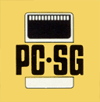 As a side note, Darius Plus is the only HuCard ever produced to also be compatible
with the SuperGrafx system (hence the PC-SG logo that can be found on the game's cover). Or to put it
correctly, the only HuCard game that can take advantage of the Supergrafx system if
present, and enhance its sprite engine and cause less flickering on screen (especially during boss
battles).
As a side note, Darius Plus is the only HuCard ever produced to also be compatible
with the SuperGrafx system (hence the PC-SG logo that can be found on the game's cover). Or to put it
correctly, the only HuCard game that can take advantage of the Supergrafx system if
present, and enhance its sprite engine and cause less flickering on screen (especially during boss
battles).
|
|
Darius was also available on CD Rom, and the game, called Super Darius
was actually
released before the HuCard version tested here. The game is fairly identical to Darius Plus,
it however features twenty six unique bosses (one for each zone), a better soundtrack (directly recorded from the
arcade game) and a short animated introduction sequence.
|
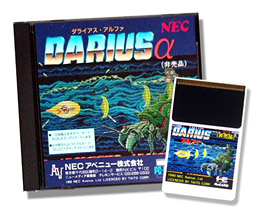 A promotional release of Darius game was created in 1990 and called Darius Alpha (picture on the right, see the Omake section).
Apparently, owners of both Darius Plus (HuCard) and Super Darius (CDRom) could mail
a proof of purchase to Taito, and be entered into a drawing for the chance to receive one of
the eight hundred copies of Darius Alpha (two hundred extra copies are believed to have been given
away by Japanese magazines at the time). A letter enclosed with the game indicates that NEC
received a total of 9762 entries! However, Darius Alpha is a bare bone boss rush,
and the goal of the game is to face all sixteen bosses from Darius Plus in a row (can be played
either in Normal or in a 4 minutes Time Attack mode). Although it doesn't feature any
A promotional release of Darius game was created in 1990 and called Darius Alpha (picture on the right, see the Omake section).
Apparently, owners of both Darius Plus (HuCard) and Super Darius (CDRom) could mail
a proof of purchase to Taito, and be entered into a drawing for the chance to receive one of
the eight hundred copies of Darius Alpha (two hundred extra copies are believed to have been given
away by Japanese magazines at the time). A letter enclosed with the game indicates that NEC
received a total of 9762 entries! However, Darius Alpha is a bare bone boss rush,
and the goal of the game is to face all sixteen bosses from Darius Plus in a row (can be played
either in Normal or in a 4 minutes Time Attack mode). Although it doesn't feature any
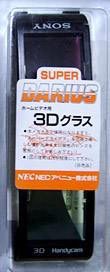 in-between stages, Darius Alpha automatically awards the player power ups after each defeated
boss. As you would have guessed, Darius Alpha is one of the rarest game available for the
PC Engine system, and copies of the game (including the original box but also the letter from Nec Avenue
and the original padded envelope) can easily fetch between $1200 and $4000 at auctions. Additionally, rare copies of
Darius Alpha were apparently autographed by the game's developer, and an unique copy even came
with a "N.1 Not For Sale Sample" sticker stamped on the game's sleeve, and was probably the
first Darius Alpha to be awarded!
As a side note, NEC Avenue also released 3D glasses for Super Darius (picture on the left)
and it is believed
that the same glasses were included with each copy of Darius Alpha. What is certain, though, is
that the glasses were also available in a blister pack with a Super Darius 3D Glasses sticker
affixed to it. The 3D glasses were manufactured by Sony (3D Handycam) and rely on a 3D
effect called the Pulfrich effect (also known as Nuoptix) - a dark lens is placed over
one eye and 'delays' the incoming image, thus simulating an apparent 3D effect (arguably, you could
take a pair of old sunglasses and remove one of the lenses out to simulate the same effect). Obviously,
the effect only works for lateral motion, but gives a convincing perception of depth to Darius
(and to any other horizontal shooters for that matter!).
in-between stages, Darius Alpha automatically awards the player power ups after each defeated
boss. As you would have guessed, Darius Alpha is one of the rarest game available for the
PC Engine system, and copies of the game (including the original box but also the letter from Nec Avenue
and the original padded envelope) can easily fetch between $1200 and $4000 at auctions. Additionally, rare copies of
Darius Alpha were apparently autographed by the game's developer, and an unique copy even came
with a "N.1 Not For Sale Sample" sticker stamped on the game's sleeve, and was probably the
first Darius Alpha to be awarded!
As a side note, NEC Avenue also released 3D glasses for Super Darius (picture on the left)
and it is believed
that the same glasses were included with each copy of Darius Alpha. What is certain, though, is
that the glasses were also available in a blister pack with a Super Darius 3D Glasses sticker
affixed to it. The 3D glasses were manufactured by Sony (3D Handycam) and rely on a 3D
effect called the Pulfrich effect (also known as Nuoptix) - a dark lens is placed over
one eye and 'delays' the incoming image, thus simulating an apparent 3D effect (arguably, you could
take a pair of old sunglasses and remove one of the lenses out to simulate the same effect). Obviously,
the effect only works for lateral motion, but gives a convincing perception of depth to Darius
(and to any other horizontal shooters for that matter!).
|
Game Staff (Copied from the end credits) :
MISSION COMPLETED
YOU DESTROYED ALL ENEMIES
AND WAR IS OVER
YOU ARE THE BRAVEST PILOT
SEE YOU AGAIN NEXT GAME
Executive Producer
Makoto Sakio
Producer
Toshio Tabeta
Directer
Kohji Matsuda
Programmer
Masashi Shimizu
Masatoshi Kanemitsu
Hideki Hacker Mesuda
Max Inde
Hi-Speed Mathpack
Junichi Ten Takao
|
|
Graphics Composer
Toshio Hyper Tabeta
Kohji Gu-Gu- Matsuda
Yasunori Bear Takahara
Recording Supervisor
Yukihiro Free Too
Kimitoshi Hashizume
Music Driver
Shigeharu Isoda
Kenichiroh Isoda
Map Convert
Takashi Ozama
Waruiko Ishibashi
Special Thanks To
Naoto Yamamoto
Tsuyoshi Matumoto
Yutaka Kubouchi
|
|
Shigenobu Nanbu
Noriaki Ohtsuka
Nobuhiro Meg Takagaki
Noriuki Watanabe
Kaoru Murohoshi
Fumiko Cuty Suzuki
Metal Yamashita
T. Hayashi
Chieko Charmy Ochiai
Chisato Yanagi
And
Fumio Kurosawa
Excelent Turbo C Compiler
and as.exe
1990 NEC AVENUE
PROGRAMMED BY BITS LAB.
LICENSED BY TAITO CORP.
|
|
O
M
A
K
E
|
|
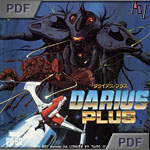
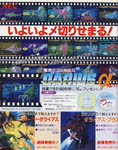
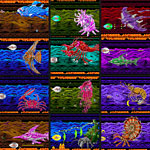
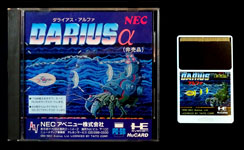
|
|
|
Click on picture to enlarge |
|
|
|
LK

|
|
Add your Pov here !
|
P
O
V
s
|
|
In my opinion, the early Darius games are a bit of a mixed bag - although I love
the squadron of unconventional and creative bosses the games throw at you, I find the levels
to be downright yawn-inducing and repetitive, and the power-up system to be painfully cumbersome.
In all respect, this PC Engine conversion is surprisingly close to the original arcade game;
graphics are more than correct (some bosses look amazing and are pure works of art) and controls are
incredibly responsive. But the game is plagued with an unforgiving difficulty level. Just picture
this - you finally upgraded your weapon after collecting countless red orbs without dying, which
seriously drained your remaining sanity and... you get hit and revert back to a pathetic putt-putt gun,
and probably won't last more than half a second against the next whatever mollusk-fossil boss...
Additionally power-orbs are extremely sparse and you will most likely always play the game with the
weakest power level (which quickly becomes a problem because boss battles come with a time limit and
new enemies appear if you linger for too long!). So Darius is like that, and if you die close to
moving up to the next power level then your chances of completing the game are nil to zero. All in all,
Darius Plus is a great conversion and looks amazing, but Super Darius
(the CDRom release
of Darius) features more bosses, a better soundtrack and a (short) introduction sequence, so
there is not much reason to purchase this version unless you really want to play Darius on
your portable GT.
|
|
|
|